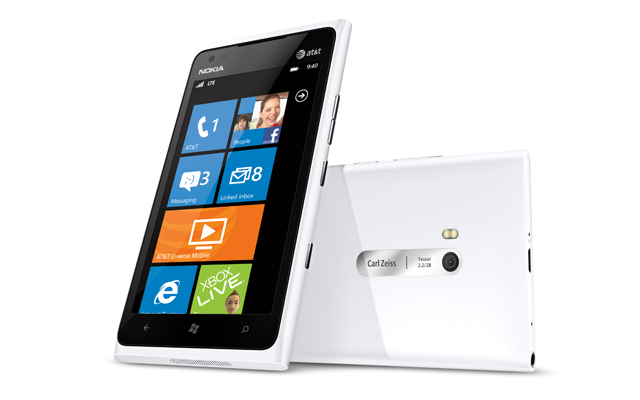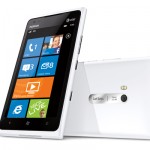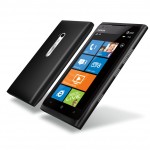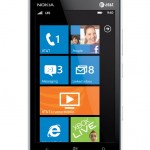review With its stellar build quality and solid featureset, the Lumia 900 is the king piece in Nokia’s attempt to win back ground lost in the ongoing smartphone wars to rival Android manufacturers and the iPhone. But does this eye-catching model do enough to overcome the limitations of its Windows Phone 7 platform? Read on to find out.
Design
Delimiter reviews of other models in Nokia’s recent handset range (the Lumia 800, for example, or the N9) have consistently praised their fantastic design and build quality. And in this respect, the Lumia 900 continues to impress. As soon as you pick up the Lumia 900, you’ll reminded of everything you love about well-designed consumer electronics gadgets. The principle reason for this is the handset’s colourful unibody polycarbonate casing, which was introduced with the N9 and Lumia 800. It returns for the Lumia 900, and it’s as wonderful to touch as ever.
It’s hard to emphasise how nice in the hand this polycarbonate casing feels. The material feels like quality plastic; with a quality of softness yet still firm; shiny but still grippable. Nokia has included rounded edges around the sides of the casing, and there are no sharp or uncomfortable bits for your fingers to get caught on. Once you start fondling the Lumia 900, you simply do not want to put it down.
The colours of the Lumia 900 are also striking. Smartphone buyers have gotten used to buying handsets in black and silver (hello, Apple), grey and black (hello, HTC) and a variety of other black and grey colours (most of the other manufacturers). But with its Lumia range, Nokia has truly broken the mould. In Australia, it also comes in a lovely off-white as well as black, and there’s a cyan colour available internationally if you import.
The rest of the Lumia 900’s design is also as striking and subtle. Its back camera floats alone as a dash of silver in a sea of colour, while its deep black front 4.3″ display contrasts markedly with the rest of its casing colour. Below the screen sits the three normal Windows Phone 7 buttons — back, the Windows key, and search.
On the top of the Lumia 900, in absolutely the most logical spot, sits is 3.5mm headphone jack, alongside a micro-USB port and the SIM card slot. On the right-hand side are volume controls, the on-switch and a dedicated camera button. On the bottom is a speaker grill, while on the left-hand side of the phone is, pleasingly, nothing.
Reviewer Jenneth Orantia wrote in her review of the Nokia N9, which features a very similar design to the Lumia 900, that it was “the best-looking smartphone” she’d ever seen. We agreed then, and now there is a new champion; the N9’s big brother, the Lumia 900. This is simply the best-looking smartphone available. Its design is stunning and it feels wonderful in the hand.
Features
As you would expect from Nokia’s top-end model, the Lumia 900 is no slouch when it comes to its featureset (full specifications here), although there are some notable caveats.
At its core the Lumia 900 runs a 1.4GHz single core CPU, with 512MB of RAM. It comes with 16GB of internal storage space, and it has a 4.3″ AMOLED screen, which is large but not overly so by today’s standards. Its primary camera is an eight megapixel model with Nokia’s special Carl Zeiss-branded optics (which usually deliver fantastic results for Nokia), and it comes with dual LED flash and auto-focus. Its front camera is a one megapixel model for video calling, and it runs the latest 7.5 version of Windows Phone 7 (code-named ‘Mango’). It supports the usual array of Wi-Fi, Bluetooth and GPS support, and will shoot video at 720p at 30 frames per second.
Nokia has also bundled in a number of major Nokia-developed applications not included by default in Windows Phone 7. These are Nokia Drive, which is a GPS navigation system for driving, Nokia Maps, which is pretty much like Google Maps (but appears a bit slicker in its level of detail transitions), and Nokia Music, which is a streaming music service and music store. There are also a few smaller apps such as App Highlights, which suggests applications for the reader.
However, not all of the Lumia 900’s features are as strong. For starters, although its screen is lovely, large and clear, with great colours and deep blacks, it only runs at a resolution of 800×480, owing to Microsoft’s standards set for Windows Phone 7. Considering that competing handsets such as HTC’s One X/XL models have a resolution of 1280×720 for their 4.7″ screen size, you can see that Nokia has a bit of catching up to do in this regard.
The Lumia 900’s network speeds are also not up to scratch with competing handsets. The XL supports 4G speeds on Telstra’s Next G network, and we’ve regularly achieved download speeds of up to 35Mbps, but the Lumia 900 doesn’t support 4G in Australia. It does do the next best — supporting the HSPA+ dual-carrier standard, which theoretically allows speeds of up to 42Mbps. Telstra’s non-4G network does theoretical speeds of between 1.1Mbps to 20Mbps. We suggest in practice users on DC-HSPA+ will usually see speeds quite a bit below 20Mbps and often below 10Mbps, and bear in mind that dual-carrier support is not available in all areas. Lesser performance is usually seen on the networks of Vodafone and Optus than on Telstra’s Next G network.
One last factor: Microsoft will release Windows Phone 8 (the next version of its Windows Phone platform) later in 2012. It is currently believed the Lumia 900 will not support this release, severely limiting its longevity.
Performance
There are several ‘hero’ facts you should know when it comes to the performance of the Lumia 900. Firstly, both its eight megapixel back camera and its one megapixel front-facing camera are very strong. We used the eight megapixel model to take a variety of photos in both low light (in fact, in the middle of the night) and during the day, and found it very hard to fault the Lumia 900’s photography skills.
Nokia has long had strong camera credentials courtesy of its partnership with lens manufacturer Carl Zeiss, and the Lumia 900 delivers in this area, even above the very strong camera found on HTC’s X/XL, for example, and at least on par with the model found on Apple’s iPhone 4S. We were surprised with how well the Lumia 900 handled low-light conditions, and the front-facing camera was also one of the best we’ve found on a smartphone.
Secondly, the user interface is absolutely stellar. We’ve reviewed various Windows Phone 7 devices over the past year, but none has really compared with the tight hardware/software integration on Nokia’s Lumia line, and the Lumia 900 is the best example of this. Just moving around the operating system, opening and closing applications was a lovely endeavour — everything was fast, seamless, and just flowed, even when you’re doing things like loading HD videos from YouTube or running intensive applications.
We feel that with Nokia’s Lumias, Windows Phone 7 is coming into its own. You really notice the difference when you move from using an Android or iOS-based phone to the Lumia 900. It’s so much more smooth and things flow so much more. This is a hard effect to detail until you see it in practice; but it’s there.
Battery life on the Lumia 900 was also strong. One of our favourite battery life tests for smartphones is to charge them fully, then leave them on our desk for two to three days. Some high-end smartphones, such as the HTC One XL, will run out of juice during this period. But the Sony Xperia Sola we reviewed yesterday survived this test, and Nokia’s Lumia 900 did even better. You’ll be able to leave the Lumia 900 untended on your desk for the better part of a week before it will run out of battery completely, unlike many high-end smartphones we play with these days.
Nokia says the Lumia 900 has a maximum video playback time of eight hours, and we have no reason to doubt this, given the performance we witnessed. It also re-charges pretty fast. This is not one of those smartphones which will perennially be running out of battery life at the wrong time, although it’s also not quite as long-lived as some smartphones in the market. Overall it’s in the mid-range, which for a high-end smartphone is actually pretty good.
Conclusion
To be honest, we are quite torn about the Lumia 900.
On the positive side, the handset has the best design of any smartphone currently on the market in Australia, and its build quality is also amongst the best on offer. Its cameras are awesome, and its battery life is better than most of its high-end rivals. In addition, its slick user interface is one of the best implementations of Windows Phone 7 we’ve seen so far. This is a smartphone which is lovely to use and which your friends, family and colleagues will want a closer look at.
But on the other hand, it’s very hard to recommend a high-end smartphone without 4G in mid-2012, given how congested Telstra’s 3G network has become in some CBD areas, and how fast and pervasive Telstra’s 4G network is becoming. In addition, there’s the low 800×480 screen resolution and the limitations of Windows Phone 7, which is currently coming a distant third in terms of third-party app support and first-party feature completeness to rivals iOS and Android. And, of course, it is doubtful whether the Lumia 900 will support Windows Phone 8, which is only a short time away.
If the Lumia 900 was a 4G smartphone, we would consider it a very strong competitor to be Australia’s current best high-end smartphone, HTC’s One XL. Without it, it’s still a fantastic handset. But it drops down to the next rung of competitors without 4G — namely, Apple’s iPhone 4S, the Samsung Galaxy S III and the HTC One X (which doesn’t support 4G). Like it or not, given today’s mobile network conditions, the rollout of 4G support in Australia is a game changer, and mobile handset manufacturers ignore that fact at their peril.
When it comes to the Windows Phone 7 ecosystem in Australia, the Lumia 900’s main competition comes from existing Nokia models such as the Lumia 800, with which it shares many features, and HTC’s Titan 4G, which does support 4G speeds. Despite its 4G support, given the Titan’s lesser build quality and battery life, we have no hesitation recommending the Lumia 900 over it as Australia’s current top Windows Phone 7 handset. It is just that much better.
To sum up: The Lumia 900 is a fantastic smartphone, and one of the best on the market. We’d like to see 4G speeds from Nokia soon in this same great hardware package; perhaps combined with Windows Phone 8, a better screen resolution and a dual-core CPU. When that happens, we believe Nokia will have an incredibly strong offering on its hands. And by its hands, we mean our hands, because we would have a very hard time stopping ourself from buying one. Your reviewer just swapped out his iPhone 4 for a HTC One XL. In 12 months’ time, will we be swapping to Windows Phone 8 with Nokia? At the moment, it’s looking quite possible.
Other reviews we liked: The Verge, CNET Australia, Engadget.
Image credit: Nokia






I believe that Microsoft’s officially confirmed that they wont be supporting the previous generation of hardware due to a total overhaul of the File System and Kernel used in Windows Phone 7.
My understanding is that because WP7 is based on Windows CE environment, not WindowsRT like WP8, theres no way for them to be able to confidently upgrade the handset to WP8 without getting everyones handsets back to the manufacturer and reloading the firmware manually from scratch. Apparently its very impractical for them to do it, so Microsoft is releasing the WP7.8 build, which will give some but not all features of the WP8 system.
Its a shame, because I would have liked to see Microsoft score points here – but its not a massive deal, given the limited market share they have.
Why no mention of the fact that the Lumina 900 WILL NOT run Windows Phone 8 OS? You are recommending people ignore the fact that they will have a phone that will be obsolete in just a few months.
Microsoft’s new “start” with its Windows Phone 8 will disappoint its current fan base. The Redmond-based company has stated that its new mobile operating system shares the Windows 8 core of its desktop OS, and that this means that older Windows Phone 7.5 device will get an update, but to Windows Phone 7.8 instead.
The update will give users some of the features that will appear in Windows Phone 8, including extra columns, resizeable tiles as well as new themes. It won’t be able to access Windows Phone 8 APIs, and won’t be able to run the new apps designed for WP8.
Not a good sign for users who have just hopped on the Windows Phone platform, especially those who have just bought the recently launched Nokia Lumia 900.
there was no mention because it doesn’t matter, and also to say it will be obsolete is ridiculous. it is no different to first generation apple iphone’s (previous to 3gs) not being able to run ios 6.
people still use 10 year old nokias and motorolas without issue.
this rampant use of the ‘windows phone 8 will make wp7 phones obsolete’ argument really gets on my nerves, because it is complete horseshit. if it is such a big deal to you (apps, certain features, etc), then wait. if not, buy a wp7 phone, you won’t be disappointed.
Your statement is incorrect. I did mention this in the review, several times:
“One last factor: Microsoft will release Windows Phone 8 (the next version of its Windows Phone platform) later in 2012. It is currently believed the Lumia 900 will not support this release, severely limiting its longevity.”
“And, of course, it is doubtful whether the Lumia 900 will support Windows Phone 8, which is only a short time away.”
i don’t mind if it wasn’t mentioned (i missed the text you have quoted, my fault), for the reasons i have outlined above. good review.
At least cite your copy-pasted word-for-word argument.
http://asia.cnet.com/windows-phone-7-5-handsets-will-not-get-wp8-upgrade-62216833.htm
Considering the paltry number of WP7 phones sold, it is quite possible that when WP8 comes out, developers will soon forget WP7 and drop support for it in their apps (after all, why put so much effort into supporting a very different and legacy OS with very few users).
And so it is quite possible that in a year’s time, your still quite-capable of one-year old Nokia handset will not only have outdated OS, it will also not run many of the current apps designed for that OS.
Microsoft and Nokia are together giving a new meaning to the Osborne effect.
Nokia seem to be going all out to destroy themselves as a company at the moment. Last 2 “prima donna” models essentially end of lifed within months of release (before release with N9 and 2 months or so after for Lumia 900).
Banking the company on MS seems an odd way for Nokia to guarantee a future for themself. Presumably Samsung / HTC etc will also be making WP8 gear, so now Nokia are directly in competition with those makers on hardware alone for the top end, and have an even smaller little market for any lower end phones. Who on earth will write apps for Nokia low to mid-range phones?
Disclaimer: I am quite happy with my N9 thankyou very much.
Wait, so after that huge rant, you’re using an N9??? Without even Windows Phone 7???
*sigh*
My point isnt that WP 7 / 8 are bad, just that Nokia decided to turn themselves into “just another handset maker” and killed their last 2 top end models. Nothing to do with the actual OS qualities.
I think many ‘tech-heads’ forget that there are people out there who will walk into a phone shop and buy whatever feels right in the hand and is on the right plan for them. Ask those people if they know about Windows Phone 8, and they’ll probably ask you what Windows Phone is.
My point was to highlight that when spending several hundred dollars to outright purchase, or opting for carrier subsidised Lumina x00 series phones, it would be fair to would-be buyers to be informed that the model is EOL (End of Life) for it’s operating system as it uses WP7.x.
I am not attempting to knock the hardware/os combination, rather just to provide fact as opposed to ‘currently believed’ and ‘doubtful’.
Correct me if I’m wrong, but wasn’t Windows Phone 7 supposed to be a ground-up rewrite of Microsoft’s phone system? That’s why all the Windows Mobile users – and unlike now, there were actually quite a few of them at the time! – had to be left behind. Sorry, but Windows Phone 7 is “the future” and Windows Mobile was built on old technology so it can’t be upgraded. Too bad for you.
Now here we are, just over a year and half later, and knock me down with a feather if Microsoft is pulling the exact same stunt! Now Windows Phone 8 is the *real* ground-up rewrite it seems. Windows Phone 7 was built on old technology so it can’t be upgraded. Too bad for you… even if you bought that shiny new Lumia only a month ago; sorry, it’s obsolete.
You don’t believe the public knows or cares about this stuff? You’re so wrong. The public isn’t anywhere near that ignorant, and the complete lack of sales of Windows Phone, 7 or 8, from this point on will only prove it.
WP7 was a complete rewrite of the application development stack. They got rid of the old C++ that was used to write native code in Windows Mobile, introduced Metro with a focus on XAML and Silverlight and other .Net technologies to develop apps. They also completely changed the application delivery method (the new app store and app privileges).
The only problem is that it ran on the same old Windows CE kernel with all its limitations. So above the kernel, it really was a rewrite, it just used the same old kernel as the old Windows Mobile 6.5.
Now in WP8, they are changing the kernel and moving the Windows Phone platform to the same Windows NT kernel on which Windows 8 will be based on. In retrospect this is what they should have done back with WP7 as well, but back then, the NT kernel didn’t run on ARM hardware and it’s taken MS a few years to port it over and iron out the bugs.
So yes, again it is a major rewrite, this time of the kernel and filesystem and other components that Microsoft calls “Windows Core”.
Some people think Windows Phone’s only problem has been marketing and PR, but the fact is that when it comes to Windows Phone, Microsoft has made many engineering decisions that in retrospect, have turned out to be the wrong ones.
Whatever you say.
But the dedicated follower of Windows Phone/Mobile/Whatever – assuming such a person exists! – has now had to take the big shaft not once, but twice in recent years.
First they were told their existing Windows Mobile devices were obsolete, with no upgrade path to shiny new Windows 7 Phone. So they ran out to buy shiny new Windows Phone 7 Phone, which, they were told were Microsoft’s future. Now, a less than two years later, they get to turn around and bend over again.
as one of those dedicated followers you mentioned (having had both a htc mozart and now a lumia 800), i feel no such shaft.
both of these phones will work just the way i expect as they do right now, for the foreseeable future.
if i want a windows 8 phone, i’ll just wait unitl my contract is up. no biggie.
please don’t generalise the thought habits of windows phone users…
funny how no-one is complaining that iphones pre-3gs will not work with ios6. it’s exactly the same thing. pre-3gs iphones will still work just fine with the older OS.
os’s evolve and leave behind old hardware. the sooner people realise this, the better.
@Shannon,
The iPhone 3 – which is the last “pre 3GS” iPhone – was released four years ago.
Windows Phone 7 is what, 18 months old?
The Windows brand has become toxic. Microsoft has shown such disdain for its customers, and shipped such flaky and encumbered products, for so long, that now there’s a real choice, those customers are returning that disdain and buying anything-but-MS in vast numbers.
Comments are closed.